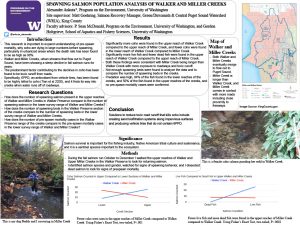Spawning Salmon Population Analysis for Walker and Miller Creeks in the Walker Preserve
Currently coho in urban streams are dying before spawning at rates of 90% which has been found to be due to runoff from impervious surfaces, and factors contributing to the salmon deaths was investigated. During my project I surveyed both Walker and Miller Creeks and compared outside variables contributing to the observed numbers of living and dead, male and female, and different species counted in each creek. The numbers of salmon counted during this survey from each species and the individuals from each species that were dead corroborated what the collective research had indicated in that coho were most susceptible to dying before spawning due to increased coverage around creeks by man made impervious surfaces which allowed 6PPD (N-(1,3-dimethylbutyl)-N’-phenyl-1,4-benzenediamine) to run into creeks from tires rolling against the surfaces. Currently the only two known options for preventing pre-spawn mortality from 6PPD are adding sand biofiltration along roadways that run off into salmon spawning streams or to replace all tires with ones that do not contain any toxic chemicals such as 6PPD. The importance of the discovery of 6PPD being the cause of pre-spawn mortality in coho is that the numbers of coho have been declining for decades, and before this article was published in December of 2020 the cause of this decline was unknown. Now that the cause is known and solutions have been proposed the process of implementing these solutions can begin in the form of infrastructure reform or with the passing of environmental legislation.
